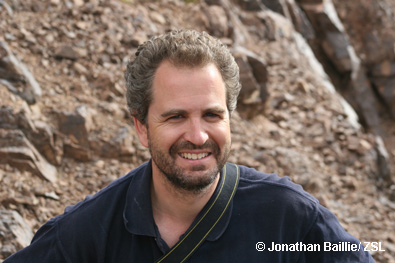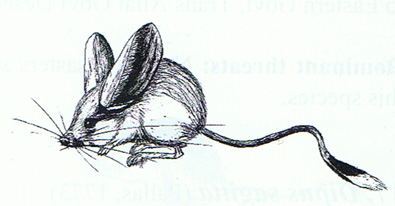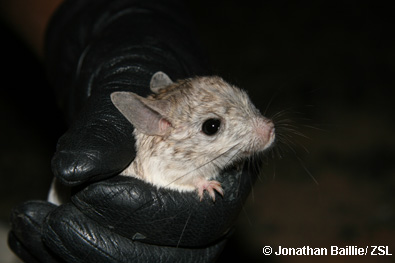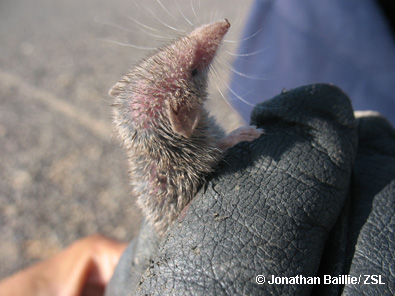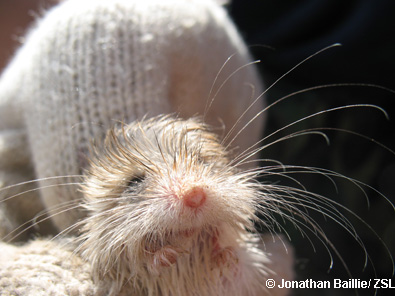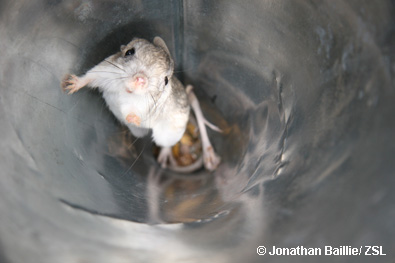[flashvideo filename=videos/hopping_final.flv width=432 height=240 image=videos/hopping1.jpg /]
Scroll down to find out more about the expedition to Mongolia’s Gobi Desert and view the first known footage of the extraordinary long-eared jerboa in its natural habitat.
Two of the top 100 EDGE species, the long-eared jerboa and the Bactrian camel, are found in the Gobi Desert of Mongolia and China. This summer I flew out to Mongolia to work with Uuganbadrakh (long-eared jerboa EDGE Fellow) and Adiya (Bactrian camel EDGE Fellow) to help them get their research studies off the ground. The reason we focused on the Bactrian camel and the long-eared jerboa is that they are one of a kind species that are believed to be on the verge of extinction. They are poorly known and little is being done to conserve them.
We embarked on a month long journey, first to visit the long-eared jerboa study site in the Little Gobi, two days drive south of Ulan Batar, and then to the camel project in the Great Gobi Special Protected Area, four days drive to the west.
Long-eared jerboas are unbelievably odd looking nocturnal creatures resembling a miniature kangaroo with a pig like snout and dumbo ears. Although there are a number of jerboa species, the long-eared jerboa (Euchoreutes naso) is the only representative of an entire genus, meaning that it is distantly related to all other creatures on the planet.
Long-eared jerboa. Clark, E. L., Munkhbat, J., Dulamtseren, S., Baillie, J. E. M., Batsaikhan, N., Samiya, R. and Stubbe, M. (compilers and editors) (2006). Mongolian Red List of Mammals. Regional Red List Series Vol. 1. Zoological Society of London, London. (In English and Mongolian)
The species has a broad distribution, spanning the deserts of both Mongolia and China, but it is believed to be restricted to very small patches within this distribution. Globally, it is listed by IUCN as Endangered and within Mongolia it is listed as Vulnerable. The cause of their threatened status is not well understood, but it has been suggested that it is due to habitat disturbance from mining activities, overgrazing and agriculture as well as possibly climate change.
As we drove out of Ulan Batar we passed Bogd Khaan National Park which has enjoyed state protections since 1778 and is often cited as the oldest national park in the word. However, rapid development around Ulan Batar is resulting in increasing pressure on the park and cutting of wildlife corridors.
The paved road abruptly came to an end and our long and bumpy two day journey to the Little Gobi had begun. The Russian vehicle we were using felt extremely sturdy, but comfort was clearly not a consideration in the design.
On the second day we picked up a family of three that had been waiting for weeks to get a lift to their farm in the Gobi desert, not far north of the Chinese boarder. The son was working as a mechanic for a mining company and had not been home in 7 years. His profession proved very fortunate when we had our first of many breakdowns. He was able to stop the oil leaking from the inside hub of the tyre by taking a piece of thread from a pair of white gloves and wrapping it around a small metal pin which then blocked the leak. I thought about that bit of thread for the rest of our precarious desert journey.
When we were up and running again it was not long before we reached the camp where Uuganbadrakh (the jerboa EDGE Fellow) was based. It is donations that have been given through this website that have provided funding for him to undertake this important conservation project.
[flashvideo filename=videos/fellow_new2.flv width=432 height=256 image=videos/fellow3.jpg /]
When we met with Uuganbadrakh he said it had been a long time since he had seen a long-eared jerboa, but that the following night he was going to take us to a place where he believed the creatures might be found. We spent the rest of the day discussing his study design and research for the future. He showed me some photos of amazing desert creatures that he had come across while setting up the study including a thick-tailed pygmy jerboa, a long-eared hedgehog and a shrew he had never seen before.
Thick-tailed Pygmy Jerboa (Salpingotus crassicauda)
Long-eared hedgehog (Hemiechinus auritus)
Siberian shrew (Crocidura sibirica)
The next day in the afternoon we all headed to the site where we hoped to locate the unusual long-eared jerboa. In the hot afternoon sun we dug small pits in the gravel to place pitfall traps and set a large number of Sherman traps. We also identified the site where the motorcycle line transect would take place that evening.
Late in the evening we headed back to the site and began the line transects with a large spotlight searching the cold desert landscape for any sign of life.
[flashvideo filename=videos/line_final.flv width=432 height=256 image=videos/line3.jpg /]
We came across many Siberian jerboas (Allactaga sibirica), Gobi jerboas (Allactaga bullata) and even a long-eared hedgehog. It was amazing to see these desert animals, but having missed the long-eared jerboa I was nervous that this almost mythical creature would escape me.
We then headed to the pitfall traps and as I walked to the first one I could hear a faint scratching noise. As I peered in the trap my eyes were met by one of the most unusual creatures that I had ever seen. I could not believe that such a strange and delicate looking animal could be at home in such a harsh environment. Upon first seeing the long-eared jerboa I was convinced that it could be the panda of the small mammal world. I knew that as soon as people learned about this little charismatic species they would be committed to ensuring its future.
[flashvideo filename=videos/pitfall.flv width=432 height=256 image=videos/pitfall2.jpg /]
When Uuganbadrakh handled the little creature and I watched the jerboa try and dig is impressive teeth into his finger, I no longer thought of it as a delicate or vulnerable species. It could quite clearly look after itself. Uuganbadrakh took body measurements, weighed it, documented the sex, checked to see if it was in breeding season and marked the species. He did this to learn more about the ecology of the long-eared jerboa and to estimate their local abundance.
When we put the jerboa on the ground we thought it would quickly hop away, but it kept following me and then tired to burrow under my foot.
[flashvideo filename=videos/feet_new2.flv width=432 height=256 image=videos/feet2.jpg /]
As we checked the traps we came across Siberian and Gobi jerboas, hamsters and many more long-eared jerboas.
We had been out all night and the sun was starting to rise. We followed one of the jerboas as it hopped away from the open gravel area into an area comprised of brush tickets and small sand mounds. The long-eared jerboa inspected a few of the sand mounds and then began to dig its burrow. We watched its unique burrowing method and were surprised to see it completely close the entrance, presumably to help regulate the temperature during the scorching hours of the day.
[flashvideo filename=videos/digging.flv width=432 height=240 image=videos/digging2.jpg /]
As we made our way back to the camp we watch the last jerboa dart into the distance.
[flashvideo filename=videos/hopping_away.flv width=432 height=345 image=videos/away2.jpg /]
It had been one of the most interesting evenings of my life. I was exhausted but could not wait until the next survey we would undertake in two nights time, just north of the Chinese boarder.
End of part 1.
To make a donation to support this important work please click here
